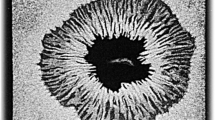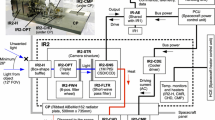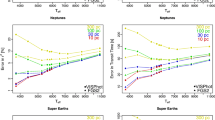Abstract
In the present work, recent characterization results of the 4K \(\times \) 4K CCD imager (a first light instrument of the 3.6m devasthal optical telescope; DOT) and photometric calibrations are discussed along with measurements of the extinction coefficients and sky brightness values at the location of the 3.6m DOT site based on the imaging data taken between 2016 and 2021. For the 4K \(\times \) 4K CCD imager, all given combinations of gains (1, 2, 3, 5 and 10 e\(^-\)/ADU) and readout noise values for the three readout speeds (100 kHz, 500 kHz and 1 MHz) are verified using the sky flats and bias frames taken during early 2021; measured values resemble well with the theoretical ones. Using color–color and color–magnitude transformation equations, color coefficients (\(\alpha \)) and zero-points (\(\beta \)) are determined to constrain and examine their long-term consistencies and any possible evolution based on UBVRI observations of several Landolt standard fields observed during 2016–2021. Our present analysis exhibits consistency among estimated \(\alpha \) values within the 1\(\sigma \) and does not show any noticeable trend with time. We also found that the photometric errors and limiting magnitudes computed using the data taken using the CCD imager follow the simulated ones published earlier. The average extinction coefficients, their seasonal variations and zenith night-sky brightness values for the moon-less nights for all ten Bessell and SDSS filters are also estimated and found comparable to those reported for other good astronomical sites.










Similar content being viewed by others
References
Altavilla G., Marinoni S., Pancino E., et al. 2021, MNRAS, 501, 2848
Baug T., Ojha D. K., Ghosh S. K., et al. 2018, JAI, 7, 1850003
Benn C. R., Ellison S. L. 1998, Nature, 42, 503
Bessell M. S. 2005, ARAA, 43, 293
Gill A., Benton S. J., Brown A. M., et al. 2020, AJ, 160, 266
Hayes D. S., Latham D. W. 1975, ApJ, 197, 593
Howell S. B. 2006, Handbook of CCD Astronomy, Vol. 5 (Cambridge: Cambridge University Press)
Janesick J. R. 2001, Scientific charge-coupled devices (Bellingham, WA: The International Society for Optical Engineering)
Krisciunas K. 1997, PASP, 109, 1181
Krisciunas K., Semler D. R., Richards J., et al. 2007, PASP, 119, 687
Kumar A., Pandey S. B., Aryan A., et al. 2020, GRB Coordinates Network, 27653, 1
Kumar A., Kumar B., Pandey S. B., et al. 2021a, MNRAS, 502, 1678
Kumar A., Pandey S. B., Gupta R., et al. 2021b, RMxAC, 53, 127
Kumar B., Sagar R., Rautela B. S., Srivastava J. B., Srivastava R. K. 2000, BASI, 28, 675
Kumar B., Omar A., Maheswar G., et al. 2018, Bulletin de la Societe Royale des Sciences de Liege, 87, 29
Landolt A. U. 1992, AJ, 104, 340
Leinert C., Vaisanen P., Mattila K., Lehtinen K. 1995, A&AS, 112, 99
Mattila K., Vaeisaenen P., Appen-Schnur G. F. O. V. 1996, A&AS, 119, 153
Mohan V., Uddin W., Sagar R., Gupta S. K. 1999, BASI, 27, 601
Nicholl M., Berger E., Margutti R., et al. 2017, ApJL, 845, L8
Pandey S. B. 2016, in Revista Mexicana de Astronomia y Astrofisica Conference Series, Vol 48, Revista Mexicana de Astronomia y Astrofisica Conference Series, 83
Pandey S. B., Yadav R. K. S., Nanjappa N., et al. 2018, Bulletin de la Societe Royale des Sciences de Liege, 87, 42
Pandey S. B., Kumar A., Kumar B., et al. 2021, MNRAS, 507, 1229
Patat F. 2003, AAP, 400, 1183
Patat F. 2008, AAP, 481, 575
Romanishin W. 2002, An Introduction to Astronomical Photometry Using CCDs, Vol. 4 (Oklahoma: University of Oklahoma)
Sagar R., Kumar B., Omar A. 2019, Curr. Sci., 117, 365
Sagar R., Kumar B., Sharma S. 2020, JoAA, 41, 33
Singh A. 2021, RedPipe: Reduction Pipeline, ascl:2106.024
Stalin C. S., Hegde M., Sahu D. K., et al. 2008, BASI, 36, 111
Acknowledgments
This study uses data observed using the 4K\(\times \)4K CCD imager mounted at the axial port of the 3.6m DOT during 2016–2021. The data of the Landolt standards in this study obtained by the imager team were used for tests and calibrations purposes. The authors of this paper are highly thankful to the observing staff and the observing assistants for their support during observations with the 3.6m DOT. AK, SBP and RKSY also acknowledge 3.6m DOT proposals DOT-2020-C2-P42, DOT-2021-C1-P55 and instrument verification nights in obtaining the data used in this study. SBP also acknowledge BRICS grant DST/IMRCD/BRICS/Pilotcall/ProFCheap/2017(G).
Author information
Authors and Affiliations
Corresponding author
Additional information
This article is part of the Special Issue on "Astrophysical Jets and Observational Facilities: A National Perspective".
Appendix
Appendix
As an example, Figure A1 represents the PTCs for obtaining the gain values for readout speed of 100 kHz and theoretical gain values of 1, 2, 3, 5 and 10 e\(^-\)/ADU. Similarly, the gain values are verified for readout speeds of 500 kHz and 1 MHz; those are tabulated in Table 1. The observations log of all the Landolt standard fields used in this study is tabulated in Table A1. The FWHM (in arc-sec; for V-band) values for all these Landolt fields (having an airmass range of \(\sim \)1–1.5) were also estimated (see Figure A2) using IRAF/imexa. Figure A2 shows the distribution of measured FWHM values in V-band for present observations distributed over 32 nights during a span of 5 years. For nearly 10% of the observed sample, <1 arc-sec FWHM values were observed. The best FWHM obtained for a point source was about 0.43 arc-sec on 17 March 2020 (see a r-band stellar image in Figure A3) along with many faint galaxies detected in the field. We have also shown the contour and radial profile of the stellar image in Figure A3, respectively. The FWHM of the stellar profile is \(\sim \)2.26 pixels which convert to \(\sim \)0.43 arc-sec using the plate scale of the CCD (0.19 arc-sec per pixel for \({2} \times{2}\) binning) on the sky.
PTCs of the 4K\(\times \)4K CCD imager taken at readout speed of 100 kHz and for all available gain values. The measured gain values are \({\sim }0.98\pm 0.05\), \(1.95\pm 0.06\), \(2.87\pm 0.10\), \(4.85\pm 0.12\) and \(9.81\pm 0.15\) e\(^-/\)ADU for theoretical gain values of 1, 2, 3, 5 and 10 e\(^-/\)ADU, respectively.
The field of SLSN 2017egm observed in r-band on 17 March 2020, for an exposure time of 600s, is shown. This image clearly detects many galaxies in the field as faint as \(\sim \)22 mag along with several faint point sources as expected with this CCD imager. The FWHM of the stellar profile (in red box) was observed as \(\sim \)0.43 arc-sec. The contour and radial profile of the stellar image are also shown.
Rights and permissions
About this article
Cite this article
Kumar, A., Pandey, S.B., Singh, A. et al. Photometric calibrations and characterization of the 4K\(\times \)4K CCD imager, the first-light axial port instrument for the 3.6m DOT. J Astrophys Astron 43, 27 (2022). https://doi.org/10.1007/s12036-022-09798-8
Received:
Accepted:
Published:
DOI: https://doi.org/10.1007/s12036-022-09798-8







